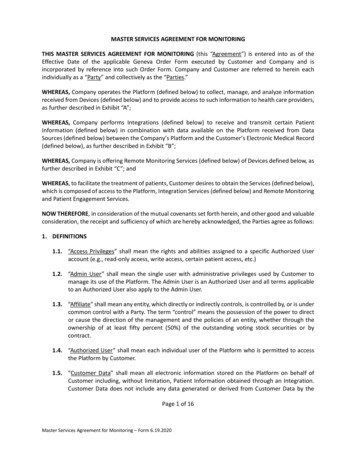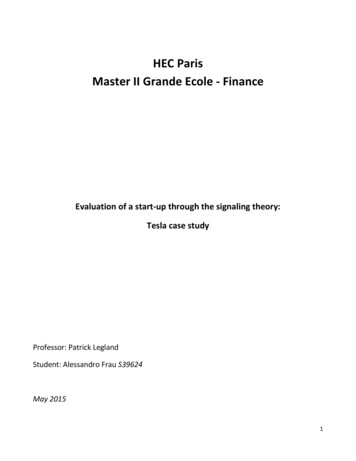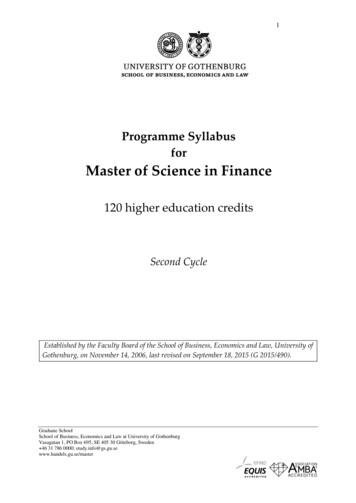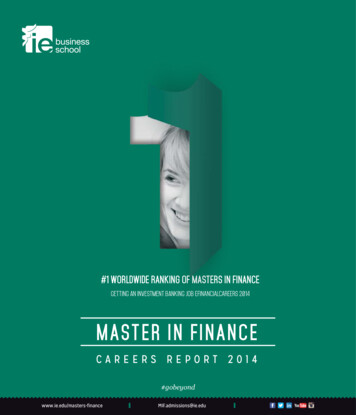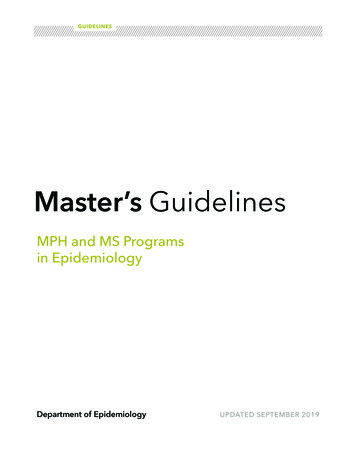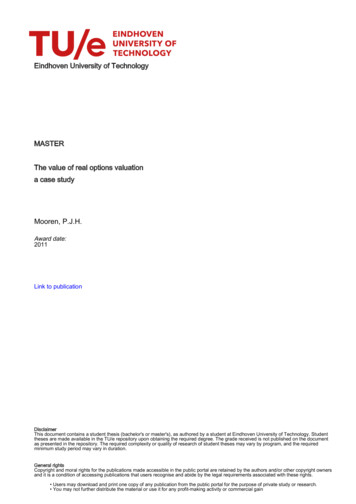
Transcription
albrechtdürermasterdrawings,watercolors,and printsfrom thealbertinanational gallery of artmarch 24 – june 9, 2013
Table of ContentsEarly Talent and TrainingLandscapes, Italian Art, and WatercolorSearch for Perfection in the Human FormCapturing Details of NatureStudies for Prints and DrawingsDrawings on Venetian Blue PaperDrawings on Prepared PaperLight and Tone in Drawings and WoodcutsThe Master Engravings and Personal CrisisWorks for Emperor Maximilian IJourney to the NetherlandsLate Works in PenThe AlbertinaNurembergMonogram
prevnextAlbrecht Dürer (1471 – 1528) was the preeminent artist of the Northern Renaissance. His bold imagination, sophisticated technique, andprobing intellect made him the German equal of Leonardo da Vinci inItaly. Dürer excelled as a painter who received many important commissions, but his most influential and innovative works were his drawings, watercolors, woodcuts, and engravings. Traveling extensively,he crossed the Alps twice, unusual for a northern artist. He broughtthe Italian Renaissance back with him, incorporating classical motifsand humanist ideals in his compositions and introducing to the northadvances in proportion and linear perspective. Like the great Italianmasters he admired, he reconciled faith and curiosity, art and sciencein his work.The finest collection of Dürer’s graphic art, including drawings andwatercolors of highly finished compositions, quick sketches, carefulstudies, and hundreds of impressions of his prints, resides in the Albertina in Vienna. The collection represents the full range of his subjectmatter, from detailed renderings of the natural world and investigations of proportion to portraits, landscapes, and religious and allegorical themes, providing keen and comprehensive insight into Dürer’sartistic development and creative genius.
Fig. 1 Self-Portrait atThirteen, 1484, silverpointon prepared paper,Albertina, Viennaprevnext
Early Talent and TrainingprevnextDürer was born in the Gothic city of Nuremberg. As was typical for the time,he began training at age twelve in the workshop of his father, a master goldsmith. In addition to learning how to shape and decorate metal, Dürer wouldhave been taught to draw and create designs for objects. His precociousnessas a draftsman is evident in his first self-portrait, made when he was justthirteen years old (fig. 1). He later inscribed it, noting proudly that “I drewthis after myself from a mirror in the year 1484 when I was still a child.”The earliest surviving dated self-portrait drawing of any European artist,the work is characterized by a firm touch and closely spaced but distinctparallel lines, as might be expected of someone who learned to incise linearimages on metal.In 1486 Dürer convinced his father to allow him to switch professions,and he was sent to apprentice in the studio of a neighbor, Michael Wolgemut,Nuremberg’s most successful painter. The young prodigy studied the arts ofpainting (including the relatively new medium of oil), drawing, and printmaking before leaving Nuremberg in 1490 to travel through northern Europe. Hespent the next four years as a journeyman, seeking to expand his knowledgeand skills by apprenticing with established artists in various towns. Althoughmost of his drawings from this period were made with pen and ink (a techniquethat became his favorite throughout his career), he sometimes worked in other
Fig. 2 The Christ Childas Savior: A New Year’sGreeting, 1493, tempera onvellum, Albertina, Viennaprevnextmedia — as for example the New Year’s greeting of 1493 (fig. 2), completed intempera on vellum or prepared calf’s skin. New Year’s cards at this time, typically woodcuts, often showed a full figure of the Christ child with symbolssuch as the orb that represented his role as Savior of the World. Dürer’s inventive composition, which he may have made to send to a friend or relative backin Nuremberg, presents the child up close as a boy playfully holding his goldenorb as though it were a ball. Dürer signed with his initials, an early version ofhis famed monogram in block capital letters.At his father’s request, Dürer returned to Nuremberg in the spring of 1494to settle down. That summer he married Agnes Frey, the daughter of a localmetalworker. She had a dowry that eventually helped him establish his ownworkshop, and well-to-do relatives from her mother’s family (one of the oldest
in Nuremberg) brought the young artist into contact with the city’s elite. Dürerdrew his future bride shortly before their marriage in a quick, intimate sketchthat suggests a shy and reflective young woman (fig. 3). During their thirtyfour years together Agnes became an able partner, helping her husband withthe business of selling his art — she sometimes took his prints to fairs in otherFig. 3 “Mein Agnes,”1494, pen and ink,Albertina, ViennaFig. 4 Agnes Dürer asSaint Anne, 1519, brushand ink on preparedpaper, Albertina, Viennaprevnextcities — and acting as occasional model; later in life she posed as the Virgin’smother, Saint Anne, in a study made for a painting (fig. 4). The couple remainedchildless, and perhaps Agnes reminded Dürer of Anne, who had no childrenuntil she conceived Mary by the will of God in her old age.
Landscapes, Italian Art, and WatercolorIn his early twenties, Dürer began to make landscapes and cityscapes in watercolor, becoming the first true master of the medium. His free handling capturedatmospheric effects even as he conveyed details with precision, as demonstratedin his view of the castle court in Innsbruck, where an overcast sky hovers abovemeticulously transcribed architecture (fig. 5).During this period works of art imported from Renaissance Italy, especiallyprints by Italian artists such as Andrea Mantegna, whose engravings he copiedFig. 5 Innsbruck CastleCourt with Clouds, 1496or later, watercolor andgouache over a faintline drawing, Albertina,Viennaprevnext
Fig. 6 Bacchanal with Silenus (after Mantegna), 1494, pen and ink,Albertina, Viennaprevnextin pen and ink (fig. 6), intrigued Dürer with their new emphasis on the nudehuman figure and subjects from classical antiquity. Perhaps inspired by them, heprobably traveled in the fall of 1494 to the artistic and trading capital of Venice.There he studied Italian Renaissance art firsthand, as well as antiquities thatadorned public spaces. Back in Nuremberg by the spring of 1496, he introduceda greater sense of monumentality in his figures.After his return to Nuremberg, Dürer continued using watercolor, notonly for architectural and landscape views, but also for figures in contemporarydress. He kept these works in his studio, often using them for details in other
Fig. 7 A Knight on Horseback,1498, watercolor, pen and ink,Albertina, ViennaprevnextFig. 8 Knight, Death and Devil, 1513,engraving, Albertina, Viennacompositions. The watercolor of an equestrian knight (fig. 7), annotated byDürer to indicate it presents “the armor of that time,” was the basis for one ofhis most famous prints made fifteen years later (fig. 8). Dürer took up printmaking actively after his Venetian trip, earning immediate fame at home and abroadthrough widely dispersed prints such as his revolutionary woodcut series on theApocolypse, published in 1498. Fifteen terrifying images illustrate the accompanying text of the Book of Revelation, including a depiction of the whore ofBabylon riding the seven-headed beast described in the scripture (fig. 9).
Fig. 9 The BabylonianWhore, 1496/1498,woodcut, Albertina,Viennaprevnext
Search for Perfection in the Human FormDürer’s interest in the nude predated his first trip to Italy, but his exposurethere to classical art and Italian Renaissance painting intensified his quest forperfection in the representation of the human body. After reading Vitruvius,the first-century BC architect whose writing on human proportions also influenced Leonardo, Dürer attempted to develop his own system. He created seriesof analytic constructions of nudes using measuring devices and compasses todivide the body into mathematically related portions (fig. 10). His quest culmiFig. 10 Male Nude (recto),c. 1513, pen and inkwith traces of chalk,Albertina, Viennaprevnext
Fig. 11 Adam andEve, 1504, engraving,Albertina, Viennaprevnextnated in his engraving Adam and Eve (fig. 11), a portrayal of the biblical couplethe moment before they eat the apple offered by the serpent, only to be expelledfrom the Garden of Eden. By 1504 Dürer was a master of the engraving technique, and this print especially demonstrates his unparalleled ability to depictlight and shade as well as an astonishing variety of surfaces and textures.Dürer’s Adam and Eve are presented as the ideal man and woman, yet theartist’s search for perfection in the human figure continued to occupy him forthe rest of his life. Eventually he changed from looking for a single model forthe male or female body to considering a variety of ideal types. This led to FourBooks on Human Proportion, a theoretical and illustrated treatise published theyear of his death, 1528.
Capturing Details of NatureDürer’s curiosity about the world was boundless. From 1500 on he made a number of extraordinary drawings and watercolors of specific animals, fish, birds,insects, flowers, and even grasses. Not necessarily meant as studies for potentialuse in other compositions, they speak to the artist’s keen interest in nature andreveal how closely he observed even its minutest details. The Great Piece of Turf(fig. 12) is a virtuoso patch of meadow seen from the perspective of a small creature. The composition balances scientific precision with artistic poetry, as theFig. 12 The Great Piece ofTurf, 1503, watercolor andgouache heightened withwhite, mounted on cardboard,Albertina, Viennaprevnext
various species of plants — all identifiable — coalesce into a unified whole filledwith light and space. Left Wing of a Blue Roller (fig. 13) meticulously examines theplumage of a migratory bird that once was common throughout Europe. Thework delights in the color and texture of the wing, its vibrant palette employedto conjure the unmistakable softness of downy feathers. Yet at the upper right,a bit of red hints at the wound of the torn appendage — Dürer’s discerning eyeleft out nothing. Exquisitely executed nature studies such as these were recognized as masterpieces already during the sixteenth century and often served asprototypes for other artists who made replicas and variations of them.Fig. 13 Left Wing of aBlue Roller, c. 1500 or1512, watercolor andgouache on vellum,heightened with white,Albertina, Viennaprevnext
Studies for Prints and DrawingsWithin the first few years of the sixteenth century, Dürer established himself asthe foremost German artist of the day. He brought assistants into his workshopto help with his many projects and prestigious commissions. For several years heemployed agents to sell his prints in other cities and countries, eventually relying instead on his wife to do the job. Dürer’s earliest surviving studies for hiswoodcuts are from this period. Comparing the sketches to his finished woodcuts provides a glimpse into his working process. After sketching out his ideason paper, he would redraw the design with fuller detail on the wood before giving the block to the cutter. The woodcut of The Visitation (fig. 14), in which theFig. 14 The Visitation,c. 1504, woodcut,Albertina, Viennaprevnext
Fig. 15 The Visitation,1503/1504, pen and grayand ink, Albertina,ViennaprevnextVirgin Mary arrives at the house of her cousin Elizabeth, adds numerous detailsthat do not appear in the swiftly sketched preparatory drawing (fig. 15), amongthem the texture of the house’s exterior, a pine tree behind the Virgin, clouds,and an imposing building with towers on the mountain. The artist also revisedparts of the composition, which was printed in reverse of the sketch, eliminatinga small cottage and fence in the middle distance and lowering the contours of themountain peaks, thereby adding more sky. Dürer used a similar process for hisengravings, finalizing the compositions on the plate as he was preparing it.
Drawings on Venetian Blue PaperDürer journeyed for a second time to Venice in late 1505, perhaps to escape anoutbreak of the plague in Nuremberg. He spent a little over a year there andbecame friends with Giovanni Bellini. While working on several importantcommissions, Dürer adopted the practice of making studies of details for paintFig. 16 The Head of an Angel, 1506,brush and ink, wash, heightenedwith white on blue paper,Albertina, Viennaprevnextings, such as heads, hands, or drapery. He used the technique of chiaroscuro(Italian for light and dark), combining opaque white gouache and dark ink onblue paper manufactured in northern Italy. Dürer’s studies are the first dateddrawings on this slightly mottled paper, manufactured from blue rags, which
Fig. 17 Drapery, 1506, brushand ink, wash, heightenedwith white on blue paper,Albertina, Viennaartists had used since the mid-fifteenth century. In studies such as the head ofan angel (fig. 16) or drapery (fig. 17), each made in preparation for altarpiecescompleted in Venice, Dürer employed fine, linear black and white brushstrokesto convey subtle qualities of light and shadow in a way that could be transferredto the tonal values of oil painting.Drawings on Prepared PaperprevnextAlthough Dürer was enamored of manufactured blue paper, he did not take anyback with him when he returned to Nuremberg in 1507. Instead, he preparedpaper himself by applying color with a brush. His most famous drawing, astudy for the praying hands of a figure in an altarpiece (fig. 18), is one of several
Fig. 18 Praying Hands,1508, brush and washheightened with whiteon prepared paper,Albertina, Viennaprevnext
made on paper with prepared blue ground that may have been an attempt toreplicate the look of manufactured Venetian paper. Düre
nique, and this print especially demonstrates his unparalleled ability to depict light and shade as well as an astonishing variety of surfaces and textures. Dürer’s Adam and Eve are presented as the ideal man and woman, yet the artist’s search for perfection in the human figure continued to occupy him for the rest of his life. Eventually .

